|
|
|


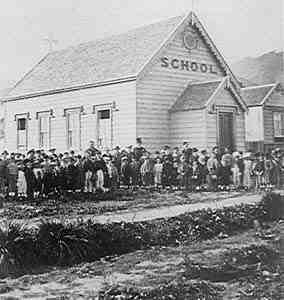 St Thomas Aquinas Boys' School |
Father Nivard Jourdan OSF was the first parish priest of Thames. He features high in the history of Thames education. Around 1869 he set up two schools: St Thomas Aquinas Boys' School and St Joseph's School for Girls (which included an Infant School). Several sources say that the school on the corner of Walter Street and Queen Street was St Patrick's School. Another source names St Bridget's School! Whatever their names, one was referred to as the Beach School and the other as the Willoughby Street School. They were staffed by lay teachers. It seems likely that the site for the WIlloughby Street School was given by Maori chiefs Rapana Maingana, Te Hoterene Hoterene and Wirope Hoterene. |
It also seems possible that the boys school and girls school swapped sites at some stage and changed names!
Father Nivard would arrange picnics and parties for the schools. The Thames Advertiser reported 23 September 1870:The children attending St Patrick's School in Queen Street were yesterday entertained by the mistress, Miss McManus. They mustered in large numbers, and partook of an excellent tea provided for them, after which they were indulged in various amusing games. An address was presented and read by Miss E. Hogan in a very clear distinct voice, which was responded to by Father Nivard, exhorting the children to attend to their studies and thereby become ornaments to society and good Christians. He proposed to give another party in the summer to the schools of Shortland and Grahamstown.The next picnic was a combined one for the two schools - at Parawai in February. Almost 400 children marched to Parawai accompanied by a bagpiper. Until 5 o'clock they were treated to cakes and lollies and ginger beer, with races and dancing and violinists. Swings had been erected. Bishop Crocke arrived on the boat from Auckland and walked with the children back to their schools.

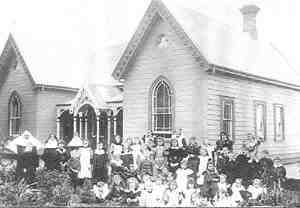 St Joseph's School and Infant School Sister Mercedes (Novice), Mother Berchmans, Sister Xavier |
At the Thames goldfields we hear of hundred of poor children running wild, wrote Mother Cecilia Maher of the Sisters of Mercy. No schools. No one to teach them. In 1874 the Sisters of Mercy arrived in Thames and took over the running of the schools. They remained until 1912. In 1874, Mother Cecilia Maher wrote: I have just returned home from the new branch formed at the Thames goldfields, a town of six years' existence, in which are four banks, hotels to no end, shops and warehouses, a large Catholic church. Please God the Sisters will do much good here, principally in the schools. |

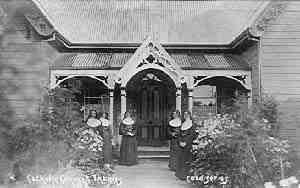 Outside the St Joseph's Convent |
The Josephites came to Thames in 1912 to replace the Sisters of Mercy in the schools. The first community in Thames consisted of Sisters Francis Borgia Coughlan, Walburg Bannock, Pacificus Buchanan and a postulant Sister Bride Flood (later Sister Ferdinand). Sisters Francis Borgia and Walburg taught in the Willoughby Street School, Sisters Anselm and Bride taught in the Beach School, and Sister Pacificus taught music in the convent. |
Over the years some, such as Sr Veronica Wenlick, Sr Angela Gould, Sr Margaret Louisson and Sr Colleen Dempsey, moved from the classroom to parish pastoral work and adult education.

At one stage, the head teacher had expelled a boy, and this was questioned by the parish priest. The headmaster's response caused the priest to say that "in the whole course of his life he had not been treated with such insolence and want of respect". Most other priests, he said, would dispense of the headmaster's services. A resolution calling for the resignation of the head teacher was lost 5 votes to 4. It was claimed that the parish priest was being dominated by one member of the committee who was also a member of the State School's Committee. It was decided to ask if the Marist Brothers could run the school.
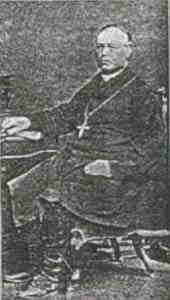 Bishop Moran |
In 1878 Bishop Moran of Dunedin made a visit to the school in his capacity of one who was immensely interested in Catholic Education. He interviewed the children, expressed delight, and then wrote suggesting improvements to the running of the parish in general and the school in particular! The head teacher of St Thomas' suggested that the questions asked the children by the bishop would have perplexed a 3rd class teacher. The bishop was "blamed" for having parents take their children away from the school. |
Another time a parishioner, who held a mortgage on the school building, threatened to close the school if the head teacher's services were dispensed with. The head teacher was dismissed, and a parish priest and a member of the committee went to get the school key. It was refused. The head teacher said he would hand the key to a man he considered to be "the leading Catholic of the Thames". The key was later recovered from "the leading Catholic", but not before he demanded a promissory note for the amount of his claim which had increased by 75 pounds for compound inmterest to 130 pounds.
In 1887, the headmaster of the school resigned without prior notice and dismissed the children at 9.40 am. Father O'Reilly, the Parish Priest, took over the school until the holidays.

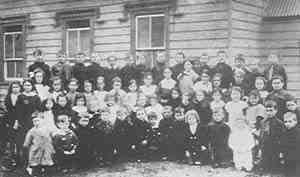 St Thomas Aquinas Boys' School |
St Thomas's first teachers were laymen. At one stage the Marist Brothers were going to run the school. The Sisters of Mercy took part in the teaching from 1874. At first, lay teachers continued to teach in the school with the Sisters. In 1877, Mr Donoghue was the Principal. The average attendance was 70. The school was financed by the collection of fees, which was set at one shilling per week for the first and second classes, ninepence for the third and fourth, and sixpence for junior classes. |
Members of the School Committee made frequent visits to parents to collect outstanding fees. Collections were made at the door of St Francis and St Brigid's Churches each Sunday, and concerts were regularly given to meet costs. In 1887, education was made free to Catholic children.
The Sisters of Mercy continued to teach at St Thomas' until 1911. When the Sisters of St Joseph replaced them in 1912, all school were amalgamated into the one school at Willoughby Street.

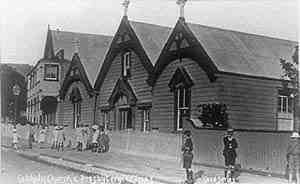 The School on Willoughby Street |
St Joseph's School began at the same time as St Thomas Aquinas Boys' School - around 1869. It was situated in Willoughby Street, although for a few years early newspaper reports speak of "the girls of St Patrick's School in Queen Street". The first teachers were laywomen, the first Principal being Miss McManus. In 1874 the Sisters of Mercy staffed and ran the school. |
Unlike St Thomas', there were no fees charged to the Girls' School. A suggestion was made that the Sisters be paid a subsidy for St Joseph's and the Infant Schools. The proposal was not adopted. In 1879 the Sisters received 63 pounds, and in 1880 they received 58 pounds. As nearly everywhere (it seems!) the Religious Community was "rescued" by one of the Sisters teaching music.
In 1881 the distribution of end of year prizes was stopped because it was "a means of causing jealousy". In all likelihood it was because the school had very little money.
The Sisters of Mercy continued at these schools until 1911, when the Sisters of St Joseph came to Thames.


1911 saw the departure of the Sisters of Mercy and in 1912 they were replaced by the Sisters of St Joseph of the Sacred Heart (Brown Josephites).
The Beach School (St Thomas') was closed in 1913 or early 1914. The three schools - St Thomas', St Joseph's and the Infant School - were all amalgamated into the one school on Willoughby Street.
A new school building was erected and on 29 April 1923 Bishop Liston opened it. It was on the site of the present tennis courts facing Mackay Street.
The last thirty years have seen many changes to St Francis'. Lay teachers once again appeared on the scene - with Miss Sheila O'Grady, Mrs Mary Martin, Mrs Mary Kedzlie and Mrs Mary Young among the first.
On 16 March 1986, Bishop Denis Browne blessed the new school buildings.


